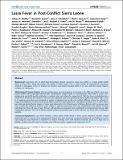Lassa Fever in Post-Conflict Sierra Leone

View/
Author
Shaffer, Jeffrey G.
Grant, Donald S.
Schieffelin, John S.
Boisen, Matt L.
Goba, Augustine
Hartnett, Jessica N.
Levy, Danielle C.
Yenni, Rachael E.
Moses, Lina M.
Fullah, Mohammed
Momoh, Mambo
Fonnie, Mbalu
Fonnie, Richard
Kanneh, Lansana
Koroma, Veronica J.
Kargbo, Kandeh
Ottomassathien, Darin
Muncy, Ivana J.
Jones, Abigail B.
Illick, Megan M.
Kulakosky, Peter C.
Haislip, Allyson M.
Bishop, Christopher M.
Elliot, Deborah H.
Brown, Bethany L.
Zhu, Hu
Hastie, Kathryn M.
Tariyal, Ridhi
Stremlau, Mathew
Matschiner, Alex
Sampey, Darryl B.
Spence, Jennifer S.
Cross, Robert W.
Geisbert, Joan B.
Folarin, Onikepe A.
Happi, Christian T.
Pitts, Kelly R.
Geske, F. Jon
Geisbert, Thomas W.
Saphire, Erica Ollmann
Robinson, James E.
Wilson, Russell B.
Henderson, Lee A.
Khan, S. Humarr
Bausch, Daniel G.
Branco, Luis M.
Garry, Robert F.
Note: Order does not necessarily reflect citation order of authors.
Published Version
https://doi.org/10.1371/journal.pntd.0002748Metadata
Show full item recordCitation
Shaffer, J. G., D. S. Grant, J. S. Schieffelin, M. L. Boisen, A. Goba, J. N. Hartnett, D. C. Levy, et al. 2014. “Lassa Fever in Post-Conflict Sierra Leone.” PLoS Neglected Tropical Diseases 8 (3): e2748. doi:10.1371/journal.pntd.0002748. http://dx.doi.org/10.1371/journal.pntd.0002748.Abstract
Background: Lassa fever (LF), an often-fatal hemorrhagic disease caused by Lassa virus (LASV), is a major public health threat in West Africa. When the violent civil conflict in Sierra Leone (1991 to 2002) ended, an international consortium assisted in restoration of the LF program at Kenema Government Hospital (KGH) in an area with the world's highest incidence of the disease. Methodology/Principal Findings Clinical and laboratory records of patients presenting to the KGH Lassa Ward in the post-conflict period were organized electronically. Recombinant antigen-based LF immunoassays were used to assess LASV antigenemia and LASV-specific antibodies in patients who met criteria for suspected LF. KGH has been reestablished as a center for LF treatment and research, with over 500 suspected cases now presenting yearly. Higher case fatality rates (CFRs) in LF patients were observed compared to studies conducted prior to the civil conflict. Different criteria for defining LF stages and differences in sensitivity of assays likely account for these differences. The highest incidence of LF in Sierra Leone was observed during the dry season. LF cases were observed in ten of Sierra Leone's thirteen districts, with numerous cases from outside the traditional endemic zone. Deaths in patients presenting with LASV antigenemia were skewed towards individuals less than 29 years of age. Women self-reporting as pregnant were significantly overrepresented among LASV antigenemic patients. The CFR of ribavirin-treated patients presenting early in acute infection was lower than in untreated subjects. Conclusions/Significance: Lassa fever remains a major public health threat in Sierra Leone. Outreach activities should expand because LF may be more widespread in Sierra Leone than previously recognized. Enhanced case finding to ensure rapid diagnosis and treatment is imperative to reduce mortality. Even with ribavirin treatment, there was a high rate of fatalities underscoring the need to develop more effective and/or supplemental treatments for LF.Other Sources
http://www.ncbi.nlm.nih.gov/pmc/articles/PMC3961205/pdf/Terms of Use
This article is made available under the terms and conditions applicable to Other Posted Material, as set forth at http://nrs.harvard.edu/urn-3:HUL.InstRepos:dash.current.terms-of-use#LAACitable link to this page
http://nrs.harvard.edu/urn-3:HUL.InstRepos:12064416
Collections
- FAS Scholarly Articles [18258]
- HMS Scholarly Articles [17920]
- SPH Scholarly Articles [6362]
Contact administrator regarding this item (to report mistakes or request changes)


